If you have been diagnosed with a spinal fracture caused by cancer or osteoporosis, KYPHON® Balloon Kyphoplasty is a treatment option you may want to consider. KYPHON® Balloon Kyphoplasty is a minimally invasive procedure that is designed to repair spinal fractures.
Before the procedure, you will have a medical exam and undergo diagnostic studies such as X-rays, to determine the precise location of the fracture. The procedure can be done under local or general anesthesia. Your physician will decide which option is appropriate for you.
KYPHON® Balloon Kyphoplasty takes about one hour per fracture treated. It can be done on an inpatient or outpatient basis, depending on medical necessity. After the procedure, you will likely be transferred to the Recovery Room for about an hour for observation. In some cases, patients may spend the night in the hospital before being discharged.
The procedure has been shown to improve mobility in patients. In fact, while in the hospital, you may be encouraged to walk and move about. Patients usually report relief from pain soon after treatment6,7,8 and many are able to walk and move about during their hospital stay6,7. In addition, patients have reported improved mental health, vitality, social function, and emotional well-being.
Your doctor will probably schedule a follow-up visit and explain limitations, if any, on your activity. Most patients report being satisfied with the procedure and are gradually able to resume activity once discharged from the hospital.
|
Balloon Kyphoplasty | |
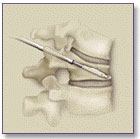 |
Step 1: Balloon Placement With a hollow instrument, a narrow pathway is made into the fractured bone. A small orthopaedic balloon is guided through the instrument into the vertebral body. The incision site is approximately 1 cm (1/3 inch) in length. Typically, two balloons are used, one on each side of the vertebral body. |
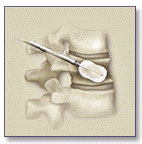 |
Step 2: Cavity Creation Next, the balloons are carefully inflated in an attempt to raise the fractured vertebral body. |
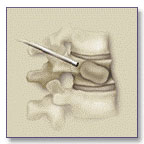 |
Step 3: Balloon Inflation Inflation of the balloons creates a cavity (space) within the vertebral body that compacts the soft, inner bone against the outer wall. The cavity also functions as a “container†for the bone cement. |
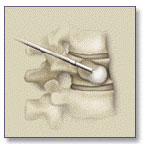 |
Step 4: Cavity Fill The cavity is filled with bone cement which is intended to stabilize the fracture. |
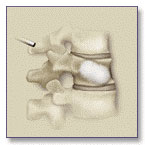 |
Step 5: Internal Cast The bone cement forms an internal cast. |
|
Images Courtesy of Medtronic | |
![]() Click Here to View Balloon Kyphoplasty Video
Click Here to View Balloon Kyphoplasty Video
Doctors trained to do the procedure include orthopedic surgeons, neurosurgeons, interventional neuroradiologists, and interventional radiologists. In addition, pain-management specialists who specialize in treating the spine may perform balloon kyphoplasty.
More than 393,000 patients and 460,000 spinal fractures have been treated with KYPHON® Balloon Kyphoplasty.
Important Safety Information
The complication rate for KYPHON® Balloon Kyphoplasty has been demonstrated to be low. There are risks associated with the procedure, including serious complications, and though rare, some of which may be fatal. These include, but are not limited to heart attack, cardiac arrest (heart stops beating), stroke, and embolism (blood, fat or cement that migrates to the lungs, heart, or brain). Other complications include infection and leakage of bone cement into the muscle and tissue. Cement leakage into the blood vessels may result in damage to the blood vessels, lungs, heart, and/or brain. Cement leakage into the area surrounding the spinal cord may result in nerve injury that can, in rare instances, cause paralysis. A prescription is required. Please consult your physician for a complete list of indications, contraindications, benefits, and risks. Only you and your physician can determine whether this procedure is right for you.
- Learn more about Balloon Kyphoplasty at www.BalloonKyphoplasty.com
- For study outcomes visit www.CompressionFractureStudy.com
- For risk and treatment options for spinal fractures visit www.spinalfracture.com
- 1Fourney, D.R. Percutaneous vertebroplasty and kyphoplasty for painful vertebral body fractures in cancer patients. J Neurosurg (Spine 1) 2003,98:21-30.
- 2Silverman, S.L., et al., The relationship of health-related quality of life to prevalent and incident vertebral fractures in postmenopausal women with osteoporosis: results from the Multiple Outcomes of Raloxifene Evaluation Study. Arthritis Rheum, 2001. 44(11): p. 2611-9.
- 3Silverman SL. The clinical consequences of vertebral compression fracture. Bone 1992;13 Suppl 2:S27-31.
- 4Gold DT, Silverman SL. The downward spiral of vertebral osteoporosis: consequences (Monograph). Cedars-Sinai Medical Center 2003.
- 5van Schoor NM, Smit JH, Twisk JW, Lips P. Impact of vertebral deformities, osteoarthritis, and other chronic diseases on quality of life: a population-based study. Osteoporos Int 2005;16(7):749-56.
- 6Garfin, S.R., R.A. Buckley, and J. Ledlie, Balloon kyphoplasty for symptomatic vertebral body compression fractures results in rapid, significant, and sustained improvements in back pain, function, and quality of life for elderly patients. Spine, 2006. 31(19): p. 2213-20.
- 7Ledlie, J.T. and M.B. Renfro, Kyphoplasty treatment of vertebral fractures: 2-year outcomes show sustained benefits. Spine, 2006. 31(1): p. 57-64.
- 8Phillips, F.M., et al., Early radiographic and clinical results of balloon kyphoplasty for the treatment of osteoporotic vertebral compression fractures. Spine, 2003. 28(19): p. 2260-5; discussion 2265-7.
- Medtronic develops and manufactures medical technologies for bone pain and other disorders, http://www.medtronic.com/
- Johns Hopkins provides information on bone pain through its Health Alerts series, http://www.johnshopkinshealthalerts.com/alerts/
- The American College of Physicians provides information on bone pain and osteoporosis at http://www.acponline.org/patients_families/womens_issues/osteoporosis/



